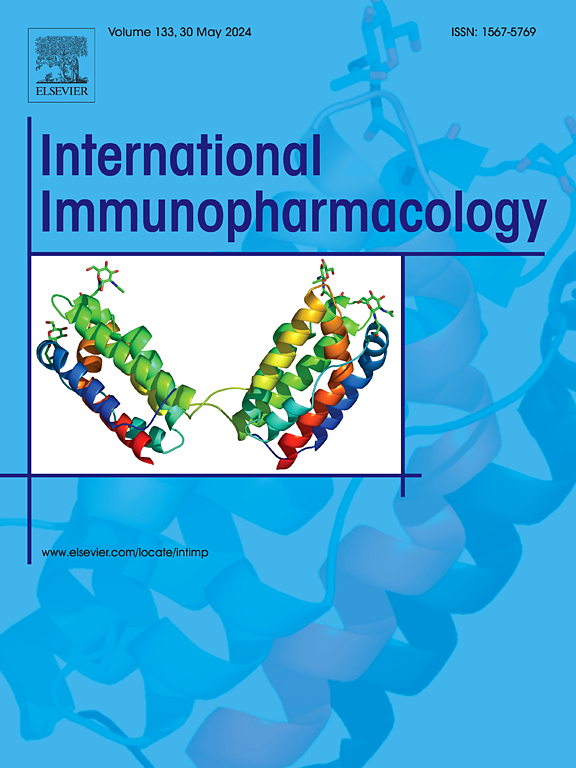Hypoxia-induced tumor cell-intrinsic PLAU activation drives immunotherapy resistance in collagenic lung adenocarcinoma
IF 4.7
2区 医学
Q2 IMMUNOLOGY
引用次数: 0
Abstract
Background
Hypoxia, as one of the hallmarks in the progression of solid tumors, has been established as critically important for tumor adaptive survival; however, its role in mediating tumor microenvironment remodeling in advanced lung adenocarcinoma (LUAD) remains incompletely defined.
Methods
Bioinformatics methods were conducted to establish a “hypoxia gene module” and perform molecular subtyping of advanced LUAD patients.Western blotting and immunohistochemistry analyses were performed to elucidate the role of PLAU-PLAUR (also known as uPA-uPAR) signaling activation in hypoxia-associated “Collagenic” LUAD development. Primary pulmonary fibroblasts were isolated, and a co-culture system was established for further investigation. QRT-PCR, Western blotting, and ELISA assays were employed to assess PLAU-PLAUR pathway involvement in CAFs activation. Additionally, CUT&RUN, mass spectrometry, immunofluorescence, and co-immunoprecipitation experiments were conducted to explore the molecular mechanisms of HIF1A-induced PLAU upregulation. In vivo studies were undertaken to examine PLAU-PLAUR activation's impact on the formation of a collagen-rich tumor microenvironment.
Results
We observed that advanced LUAD patients with high hypoxia exhibited higher fibrosis and increased infiltration of immunosuppressive cells in their microenvironment. Screening intercellular communication signals revealed abnormal activation of the PLAU-PLAUR pathway between tumor cells and fibroblasts in hypoxia-induced “Collagenic” LUAD. In vitro experiments confirmed that hypoxia upregulates PLAU in tumor cells, promoting CAFs activation. Furthermore, hypoxia-inducible factor 1α(HIF1A) recruits the mitophagy protein NIX for a non-canonical role: under hypoxia, NIX translocates to the nucleus, interacts with the PLAU transcription factor YY1, and enhances its binding to the PLAU promoter. We also identified that PLAU activates Hippo-YAP signaling upon binding to PLAUR on lung fibroblasts. In vitro studies demonstrated that Upamostat significantly attenuated fibroblast activation at tumor borders, enhanced CD8+T cell infiltration, and shifted macrophages from immunosuppressive to immunogenic states.
Conclusions
Activation of the PLAU-PLAUR pathway is essential for the progression of hypoxia-associated LUAD exhibiting a collagenous phenotype. Blocking the pathway provides a new research perspective for the development of immunotherapy for LUAD.

缺氧诱导的肿瘤细胞内禀PLAU激活驱动胶原肺腺癌免疫治疗抵抗
缺氧作为实体瘤进展的标志之一,对肿瘤适应性生存至关重要;然而,其在晚期肺腺癌(LUAD)中介导肿瘤微环境重塑的作用仍不完全明确。方法采用生物信息学方法建立“缺氧基因模块”,并对晚期LUAD患者进行分子分型。Western blotting和免疫组织化学分析阐明了PLAU-PLAUR(也称为uPA-uPAR)信号激活在缺氧相关的“胶原性”LUAD发展中的作用。分离原代肺成纤维细胞,建立共培养体系进行进一步研究。采用QRT-PCR、Western blotting和ELISA检测来评估PLAU-PLAUR通路参与CAFs激活。此外,我们还通过CUT&;RUN、质谱、免疫荧光和共免疫沉淀实验来探索hif1a诱导PLAU上调的分子机制。研究人员进行了体内研究,以检验PLAU-PLAUR激活对富含胶原的肿瘤微环境形成的影响。结果我们观察到晚期LUAD患者高缺氧表现出更高的纤维化和微环境中免疫抑制细胞的浸润增加。筛选细胞间通讯信号发现,在缺氧诱导的“胶原性”LUAD中,肿瘤细胞和成纤维细胞之间的PLAU-PLAUR通路异常激活。体外实验证实,缺氧可上调肿瘤细胞PLAU,促进CAFs活化。此外,缺氧诱导因子1α(HIF1A)募集线粒体自噬蛋白NIX发挥非规范作用:在缺氧条件下,NIX易位到细胞核,与PLAU转录因子YY1相互作用,并增强其与PLAU启动子的结合。我们还发现,在肺成纤维细胞上,PLAU与PLAUR结合后激活希波- yap信号。体外研究表明,Upamostat可显著减弱肿瘤边缘成纤维细胞的活化,增强CD8+T细胞的浸润,并将巨噬细胞从免疫抑制状态转变为免疫原状态。结论PLAU-PLAUR通路的激活对于缺氧相关LUAD的进展至关重要,并表现为胶原表型。阻断该通路为LUAD免疫治疗的发展提供了新的研究视角。
本文章由计算机程序翻译,如有差异,请以英文原文为准。
求助全文
约1分钟内获得全文
求助全文
来源期刊
CiteScore
8.40
自引率
3.60%
发文量
935
审稿时长
53 days
期刊介绍:
International Immunopharmacology is the primary vehicle for the publication of original research papers pertinent to the overlapping areas of immunology, pharmacology, cytokine biology, immunotherapy, immunopathology and immunotoxicology. Review articles that encompass these subjects are also welcome.
The subject material appropriate for submission includes:
• Clinical studies employing immunotherapy of any type including the use of: bacterial and chemical agents; thymic hormones, interferon, lymphokines, etc., in transplantation and diseases such as cancer, immunodeficiency, chronic infection and allergic, inflammatory or autoimmune disorders.
• Studies on the mechanisms of action of these agents for specific parameters of immune competence as well as the overall clinical state.
• Pre-clinical animal studies and in vitro studies on mechanisms of action with immunopotentiators, immunomodulators, immunoadjuvants and other pharmacological agents active on cells participating in immune or allergic responses.
• Pharmacological compounds, microbial products and toxicological agents that affect the lymphoid system, and their mechanisms of action.
• Agents that activate genes or modify transcription and translation within the immune response.
• Substances activated, generated, or released through immunologic or related pathways that are pharmacologically active.
• Production, function and regulation of cytokines and their receptors.
• Classical pharmacological studies on the effects of chemokines and bioactive factors released during immunological reactions.

 求助内容:
求助内容: 应助结果提醒方式:
应助结果提醒方式:


